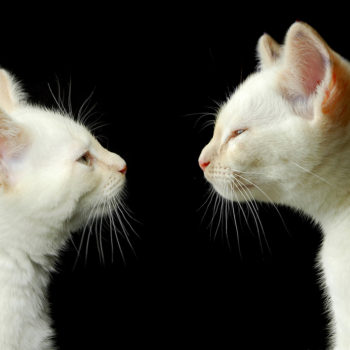What if you could sprinkle magic fairy dust to reduce fighting between cats in a family? That would certainly help keep cats in their homes, and encourage people to adopt multiple cats, so we wish we could tell you magic anti-cat fight fairy dust was a thing. What we can tell you is there’s something a lot more scientific and actually real that can help reduce fighting between housemate cats.
Inter-cat aggression is an incredibly stressful situation for cat lovers. It can strike cats who have lived together in harmony for years, or not occur until a new cat joins the household. Whatever the circumstances, it can put domestic peace at risk, and lead to the injury or relinquishment of cats. In a study on treating inter-cat aggression published in the Journal of Feline Medicine and Surgery, the authors, headed by boarded veterinary behaviorist Dr. Theresa DePorter, wrote:
Once conflicts occur, cats may continue to exist in a tense social situation for months or years, which affects their daily welfare, increases stress and reduces freedom to access resources without fear of confrontation. Harmony in any household is desirable and a cat that does not get along with a housemate cat faces a greater risk of relinquishment, daily stresses and potential for injury. In addition, there are cats living in shelters that would be candidates to be added to homes if owners could be sure their cats would get along. The wellbeing of millions of cats may be enhanced if cats got along with housemate cats.
While there are other interventions that can address fighting between housemate cats, they can be difficult to implement for most cat owners. In the study, the researchers looked at the effectiveness of one that’s very easy to utilize: the use of pheromones. Pheromones are natural substances that cats produce in their glands in order to communicate messages to other cats. They use them to mark territory, and can signal a cat’s emotional state while influencing that of other cats.
One such chemical signal is known as the feline-appeasing pheromone, and it’s produced by a mother cat’s mammary sebaceous glands during the entire period during which her kittens are nursing. These pheromones are associated with comfort, security, and the formation of social bonds during kittenhood. The authors wrote:
Kittens will form strong social relationships during the ‘sensitive period’ or the window of optimal socialization that occurs between 2 and 7 weeks of age. Curiously, during these first few weeks of age is the time of natural cat-appeasing pheromone release by the queen; coincidentally or causally at a time when kittens are living in groups with very few conflicts and competition. When they are adults, however, cats may not invest significant energy in maintaining social bonds or reconciling broken bonds following conflict.
They looked at two groups of cats, one where pheromones were used in a diffuser, and another where a placebo was used instead, finding that:
- The pheromones were associated with a reduction in feline aggression in multi-cat households.
- Aggression reduced even before pheromone treatment when owners were given tips from a veterinary behaviorist, including how to respond to aggressive events and to avoid punishment such as squirt guns or other startle methods.
- It took four weeks for the positive effect of pheromones to take hold.
- Declawing was associated with increased aggression in the home.
They concluded, “[E]ducating owners regarding the meaning of feline postures, charting progress by means of the Oakland Feline Social Interaction Scale, ceasing of punishment, implementing classical conditioning and use of an appeasing pheromone that enhances social interactions together provide a complete professional program for assisting owners and their cats.”
So it’s not fairy dust, but the use of pheromones may help resolve some cases of feline fighting, and may also make it easier to introduce new cats into the family. And we think that’s pretty magical!
DePorter TL, Bledsoe DL, Beck A, Ollivier E. Evaluation of the efficacy of an appeasing pheromone diffuser product vs placebo for management of feline aggression in multi-cat households: a pilot study. J Feline Med Surg. 2018 May 1;:1098612X18774437.

